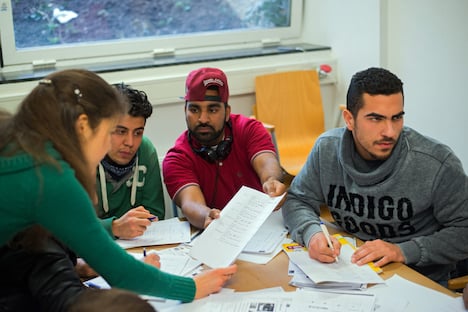A restaurant owner in Salzburg is training and employing refugees, urging others to follow suit. And inhabitants of Kaltenleutgeben have taken refugee families under their wings, giving them tours of the town’s museum and sharing meals. Locals believe newcomers integrate faster with practical assistance than with pity.
While their government has closed Austria’s borders, saying that the 90,000 asylum requests Vienna received in 2015 overwhelmed the country, Austrians in local communities have moved to the next stage: integration. And they are more upbeat than the politicians arguing every night on television over asylum and migration policies.
Austria’s Willkommenskultur, or welcoming culture, may have disappeared among the political class, but not among the people. Many volunteers say they cannot afford for integration—bringing people of different countries and cultures into society—to fail. They simply roll up their sleeves and try to make it work.
This is happening not only in Austria but all over Europe. While the media were focusing for the most part on EU summits, arson attacks on German refugee hostels, or disputes about Muslims sleeping in churches, Dutch mayors recently asked the government to stop talking about zero migration and instead fine-tune the practicalities of integration.
The mayors say the absorption of small groups of 100–200 newcomers works well in most communities, especially in the countryside, where buildings stand empty. Volunteers are active everywhere, organizing football tournaments and Dutch language classes. The city authorities in Amsterdam now help asylum seekers find jobs before they even have papers.
In Germany, musicians of the Freiburg Baroque Orchestra teach refugee children about classical music. And in Bavaria, whose Premier Horst Seehofer urges German Chancellor Angela Merkel to shut the country’s borders, towns and villages hand out refugee aid like clockwork.
Excel sheets show aid workers where volunteers are needed for night shifts or which communities need cars to drive refugees to the hospital. Individuals, NGOs, and churches work together.
For many, integration is not a choice but a duty. A retired pharmacist who does not like Merkel’s open-door policy toward the refugees wants to teach German. “Everyone helps,” she says. “Otherwise it will be a disaster.”
Most volunteers are doers, not dreamers. Their apolitical approach does not reflect the political gloom enveloping Europe. With extremist and populist parties on the rise in Europe, governments are afraid of a political backlash.
Countries like Austria, Germany, the Netherlands, and Sweden have welcomed people fleeing wars and repression before: Hungarians in 1956, Vietnamese in the 1970s, and refugees from the former Yugoslavia in the 1990s.
This time, public attitudes are more reserved. Already battered by economic and political crises, Europeans worry about terrorism and their ability to absorb many more Muslims into their societies.
So when the Dutch city of Arnhem received 400 refugees in September 2015, many feared a backlash in the neighborhood. But local inhabitants came to the former prison where the refugees were housed, offering cakes, toys, and help. It was moving, one Arnhemmer said. “Suddenly the refugees became Tariq from Homs and Yasmin from Aleppo.”
At a recent Viennese lunch with middle-aged, bourgeois women, it turned out several of them do refugee work. One of them is trying to get Syrian medical diplomas recognized in Austria. The women said that the initial bureaucratic chaos of summer 2015 had eased.
That chaos erupted because as in the Netherlands, the Austrian authorities distribute refugees throughout the country’s regions. Initially, the government in Vienna dispersed only groups of 1,000 asylum seekers or more, rejecting offers of smaller lodgings, claiming it was too much effort for too few people.
Most provincial governors had to be forced to accept asylum seekers. Some governors sent them straight on to villages with mayors from rival political parties. An imperial cadet school in the Austrian town of Traiskirchen, originally built for 500 people and 110 horses, had to put up almost 5,000 asylum seekers in summer 2015.
Traiskirchen’s mayor is a Socialist, the provincial governor a Conservative. The situation was a mess, which both parties used to score points. Asylum seekers slept in the streets, with municipal regulations preventing additional beds from being put up. Citizens brought clothing, food, and phone cards. Amnesty International called the situation scandalous.
Kilian Kleinschmidt, a German aid worker who until recently managed a refugee camp in Jordan for 80,000 Syrians, says the EU’s 500 million citizens should have no trouble absorbing 1.5 million newcomers. “Major airports manage millions a day. You just need the will to organize it.”
He also says things are improving on the local level. He hooks up investors, city planners, and Google executives with energetic Syrians who are clever with computers and have plenty of time. “[The investors] see the [refugees’] potential,” Kleinschmidt says, citing the success of networks such as Techfugees, which brings together tech engineers and NGOs, and workshops like Fab Lab that offer refugees access to digital technologies.
Pressure is mounting everywhere to allow asylum seekers to work. Alexander Van der Bellen, a candidate in Austria’s 2016 presidential election who is standing as an independent but is supported by the Greens, recently visited asylum seekers who had arrived months earlier but were still waiting for their first interview. He described the situation as unacceptable.
Friedrich Schneider, an expert on Europe’s shadow economy, is calling on governments to let asylum seekers and refugees work on the black market. “There is nothing worse than sitting on your bed the whole day, feeling useless and excluded,” he says. Austrian economists estimate expenditure on asylum seekers and refugees has already boosted the country’s economic growth. If the migrants start working on the black market, this growth will accelerate.
Letting refugees contribute to the informal economy could work wonders in Limburg, a Dutch province whose population is shrinking by 4,000 people a year. There, 1,200 houses are demolished each year. Limburg currently has 4,000 asylum seekers, but the provincial authorities are relaxed about the newcomers.
Schools, churches, and factories stand empty, so housing a few hundred people in local communities is relatively easy—if the central government permits it. Yet that is not always the case: recently, the Dutch government sent asylum seekers to The Hague but only allowed the city authorities to house them in an empty ministry if the city agreed to buy the building.
The arrival of refugee children has already prevented one Dutch village school from closing. Volunteers in Limburg are active and motivated in integrating refugees—even though some of them vote for Geert Wilders, an anti-immigration politician from the province. Nedcar, an independent Dutch car manufacturer, is eager to hire asylum seekers.
Extra hands are urgently needed in agriculture as well. Here, too, the message seems to be that bureaucratic inflexibility and boredom among asylum seekers are hindering integration more than an unwelcoming attitude among citizens. It is perhaps time politicians took notice.
Caroline de Gruyter is a Europe correspondent for the Dutch newspaper NRC Handelsblad. She is based in Vienna.
Originally published on the Carnegie Europe's Strategic Europe blog.



 Please whitelist us to continue reading.
Please whitelist us to continue reading.